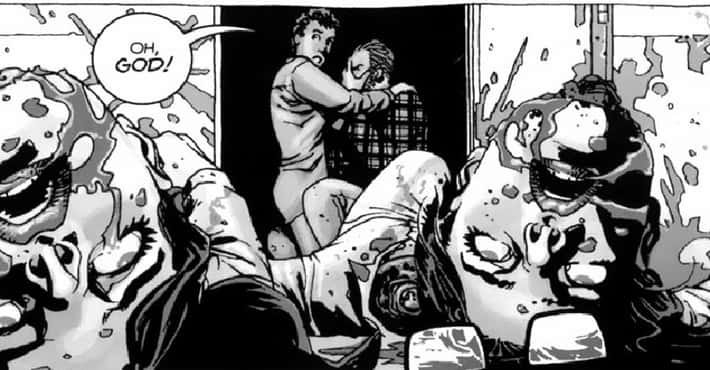
Special Effects Secrets From Behind The Scenes Of 'The Walking Dead'
The Team Covered One Actor's Face In Dirt To Achieve A Twisting Effect
Photo: AMCThe team behind TWD's special effects uses practical effects and makeup whenever possible. These are not only cheaper - they often look more realistic. But how exactly do you make an actor look like their face is twisted backwards?
In one scene from Season 8, a walker trips when its foot is caught in a steel fence, which sends it toppling over onto its belly. Unfortunately, its head is twisted all the way around to face up. Executive producer and director Greg Nicotero provided insight into the gruesome frame: "We did a full prosthetic makeup on the performer; then, we dug a hole in the ground and [covered] his face, then put an animatronic head on top of his head, so we could turn it all around."
Each Episode Uses 20 To 30 Gallons Of Fake Blood
Photo: AMCMost of the time, the monsters on TWD are a little worse for wear - most have at least one limb missing. When combined with the show's countless onscreen fatalities, some fake blood is going to be inevitable.
Each episode requires massive amounts of red ooze, and it's all made on set by the special effects department. According to Nicotero, "[TWD] probably uses up the most amount of blood that we've ever had on any show. I would say per episode, we're usually somewhere in the 20 to 30 gallons range."
The Crew Uses Different Shades And Textures Of Blood, Depending On The Need
Photo: AMCDifferent situations call for different types of blood: Arterial blood is bright red, while blood from the veins is often a much darker shade. Similarly, dried blood doesn't look much like fresh, dripping blood, and vice versa.
According to Nicotero, the special effects team uses several different recipes to make realistic blood, depending on how it will be used. He explained, "We have dark zombie blood, we have dried blood, we have coagulated blood. If you have a shirt like my shirt which is dark, and you want to see the blood on it, it has to be brighter, otherwise, it would just fade in with the color."
Shiva The Tiger Is Just A Stunt Man In A Blue Body Suit
Photo: AMCThe CGI tiger used on the show looks exceptionally realistic, and fans could be forgiven for thinking it's real - though it most certainly isn't. While throwing a real animal onto the set would undoubtedly have been cheaper, the rules and regulations surrounding the safety of both the animal and crew necessitated an animated version.
Scott Hunter, a stuntman, threw on a mocap suit to act as the on-set stand-in for Shiva. Every time we see the tiger jump on someone and tear out their jugular, it's actually Hunter decked out in a blue bodysuit.
Actors Are Sent To 'Zombie School' To Perfect Their Performance
Photo: AMCTWD's Zombie School is designed to train performers in the classic stumbling-and-groaning style of zombie acting. Actors are told to be quiet - while walkers make plenty of noise on the show, it's all added in post-production. This not only makes the sound design more homogenous, but it also cuts out any random sneezes, coughs, or other involuntary sounds from the actors. According to Nicotero:
I grade [the auditioning zombie extras] on two criteria: look and performance. We have a visual aesthetic that is really important to the show and the zombies, that they look thin and gaunt and emaciated. We tend to go with thinner people who have a specific kind of bone structure, so when we put prosthetic on them, because makeup is an additive process, it doesn't look like we're building out their face too much. The second part of it is performance. The actor has to bring it to life. It's very important that our walkers are genuine and authentic.
Anyone who gets past the casting agents continues their audition by attending the school, which instructs actors on the proper way to move, walk, and bite people. While the students are there, the effects artists measure them for their costumes and prepare everything for their onscreen performance.
The Show Features Three Different Types Of Zombies
Photo: AMCTWD features three distinct types of zombies: those wandering around in the back of the frame, those in the middle distance, and those up close to the camera. Zombies placed in the distance don't require much makeup at all - maybe just a splash of fake blood and some dirty clothes. The zombies in the middle distance need some makeup, shading, and a little blood.
Those in the foreground, however, get the full-on makeup treatment. Even if they're only on screen for a few seconds, they need to look as nasty as possible, which is why those monsters take the most time to prepare for a scene.
Nicotero spelled out the process in a 2012 interview with CNN:
Days that we have 60 or 70 [zombies], we break it down where we have "hero" makeups, which are features, and "midground" makeups, which are paint jobs, where we paint highlights and shadows on their faces to make them look dead, but they're not intended to get too close to the camera.
The Effects Team Can Make Up An Actor In Roughly 90 Minutes
Photo: AMCOn average, a TWD actor can be made up to look like a zombie in about an hour and a half. The process is very streamlined, meaning there's plenty of customization accomplished beforehand. Each actor is fitted with their own dentures and contact lenses. They also have 3D-molded prosthetics made for their faces alone, which require some prep-work and artistry.
A team of four makeup artists spends up to 90 minutes getting everything just right for each actor. According to Nicotero, the team often doesn't know who's coming in on any given day:
The extras come into the trailers; we don't know who is coming in, and it's sort of like having a new canvas every single time. They all have contact lenses; they all have custom dentures; some people we like to make more rotted than others. It all depends on the character and what we want to do on that particular day.
To Prevent Zombie Actors From Overheating, The Team Only Uses Partial Masks
Photo: AMCTWD is filmed in Georgia, a place known for its extreme heat and humidity. This can pose problems when actors are required to wear heavy latex masks or suits. Early on in the series, the special effects and makeup artists decided they couldn't use full masks, which is why most of the zombies wear 3D transfers only applied to portions of their faces.
In full masks, the actors would overheat quickly under the Georgia sun. This requirement forced the artists to become innovative, and as the show developed, the team created new methods to make the zombies look more gruesome and far more interesting. The showrunners, including Nicotero, also want to make the zombies look less "fresh" as time progresses:
The longer the show exists, the more we’re dealing with the fact that some of these beings have been walking around for years. The leathery skin, the emaciated look, the pronounced bone structure - we’re trying to convey the passage of time with the decay of these zombies.
Greg Nicotero Applies His Biological And Anatomical Studies To The Show
Photo: Angela George / Wikimedia Commons / CC BY-SA 3.0Before he became involved with TWD, Nicotero got his start working for George Romero on Day of the Dead. He continued to work in horror with the legendary John Carpenter, among many others.
Nicotero's interest in cadavers has some real-world roots, thanks to his study of biology in college. His love for medicine and biology clearly translates into the VFX artistry of the show, and an incredible amount of detail is applied to the nuances of the zombies' skin and muscle.
In a 2018 interview, Nicotero described some of his methods: "We try to make it look as real as can be. If you pull the skin back on some of these zombies, you’ll see different layers of things underneath."
Walkers Are Covered With Sunscreen
Photo: AMCGeorgia is both hot and humid in the summer, but just because an actor is playing a zombie doesn't mean they shouldn't care for themselves. Actors are often coated with sunscreen, as many are required to meander about in the background for an extended period of time on a hot day.
The sunscreen is mostly used for the actors' protection, but it also keeps them from overheating and sweating, which Nicotero claims a zombie wouldn't do:
Before they walk out the door, we spray them with sunscreen. It actually sets the makeup well. If they're lying on hot pavement, we cut out neoprene sheets in the shape of their body and use silver boards to reflect the sun away from them. If a zombie starts getting red or perspiring, that doesn't look like somebody who is [deceased].
The Makeup Team Goes Through A Ton Of Hair Conditioner Every Week
Photo: AMCOne aspect of zombie creation that often goes unnoticed is the hair. Since these monsters have supposedly been wandering in the hot sun for years, their hair should reflect that - it should be matted with mud, blood, dirt, and whatever else they may have encountered. According to Nicotero, the makeup crew uses plenty of conditioner every week to achieve a flat, greasy look:
We spend a lot of time eliminating anything that would make a zombie look like she was recently at a salon. One time, an extra showed up with purple hair, and we had to spend two hours changing the color of it. It doesn't make sense to see a zombie with purple hair. We use conditioner to make it look flat, greasy, and matted. We go through four bottles of Alberto VO5 conditioner a week.
Makeup Is Applied In An Assembly Line
Photo: AMCTurning a camera-ready actor into a walking zombie is no easy task, but TWD's artists have it down to a science. Nicotero revealed that, in order to ensure the team can make up enough people in as short a period of time as possible, four artists arrange themselves in an assembly line, with each performing a specific task over and over again:
We have an assembly line of four artists that can finish 40 to 50 zombies in an hour. The first makeup artist shadows around the eyes and cheekbones, the next person does a lighter color over the highlights to accentuate the bone structure, the next person spatters blood, and then the last person puts conditioner in their hair.
This gets them through an entire horde of zombies in only an hour, whereas doing it one person at a time could take an entire day. For a series that deals with dozens of primary actors and extras who need to me made up every day, an assembly line is undoubtedly the most efficient solution.





































